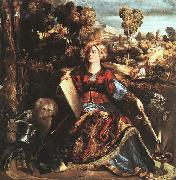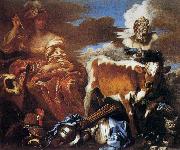Wholesale Oil Painting No Minimum |
|||||||||||
|
|
|||||||||||

|
|||||||||||
|
|
|
||||||||
Dosso Dossi1479-1542 Italian Dosso Dossi Locations Italian painter of the Ferrarese school, whose real name was Giovanni di Niccolo de Luteri. He may have been a pupil of Lorenzo Costa, but was certainly influenced by Giorgione, Titian, and Raphael. He often collaborated with his brother Battista, a landscape painter. Dosso Dossi is first recorded in Mantua, but after 1514 he executed many decorative works for the ducal palace and churches of Ferrara, including frescoes, pictures, and cartoons for tapestries. Both his landscapes and portraits show originality and imagination. He was a friend of Ariosto, who mentions him in Orlando Furioso. His works include Circe in the Woods (Borghese Villa); The Three Ages of Man (Metropolitan Mus.); The Standard Bearer, Scene from a Legend, and Saint Lucretia (National Gall. of Art, Washington, D.C.). |
||||||||
|
|
||||||||
Circe
Circe Painting ID:: 993 |
Borghese Gallery, Rome Borghese Gallery, Rome |
|||||||
|
|
||||||||
Dosso Dossi1479-1542 Italian Dosso Dossi Locations Italian painter of the Ferrarese school, whose real name was Giovanni di Niccolo de Luteri. He may have been a pupil of Lorenzo Costa, but was certainly influenced by Giorgione, Titian, and Raphael. He often collaborated with his brother Battista, a landscape painter. Dosso Dossi is first recorded in Mantua, but after 1514 he executed many decorative works for the ducal palace and churches of Ferrara, including frescoes, pictures, and cartoons for tapestries. Both his landscapes and portraits show originality and imagination. He was a friend of Ariosto, who mentions him in Orlando Furioso. His works include Circe in the Woods (Borghese Villa); The Three Ages of Man (Metropolitan Mus.); The Standard Bearer, Scene from a Legend, and Saint Lucretia (National Gall. of Art, Washington, D.C.). |
||||||||
|
|
||||||||
|
|
circe
circe Painting ID:: 71076 |
mk289 1514-1516 washington national gallery of art samuel h kress collection mk289 1514-1516 washington national gallery of art samuel h kress collection |
||||||
|
|
||||||||
Giovanni Benedetto Castiglionewas an Italian Baroque artist, painter, printmaker and draftsman, of the Genoese school. He is best known now for his elaborate engravings, and as the inventor of the printmaking technique of monotyping. He was known as Il Grechetto in Italy and in France as Le Benedette. |
||||||||
|
|
||||||||
|
|
Circe
Circe Painting ID:: 96074 |
circa 1650(1650)
Medium oil on canvas
cyf circa 1650(1650) Medium oil on canvas cyf |
||||||
|
|
||||||||
wright barkerfl.1891-1953,d.1941 |
||||||||
|
|
||||||||
|
|
Circe
Circe Painting ID:: 97061 |
1889
Medium Oil on canvas
Dimensions 138 X 188 cm
cyf 1889 Medium Oil on canvas Dimensions 138 X 188 cm cyf |
||||||
|
|
||||||||
|
wright barker fl.1891-1953,d.1941 Circe 1889 Medium Oil on canvas Dimensions 138 X 188 cm cyf |
||||||||
|
|
||||||||
|
Prev Next
|
||||||||
|
|
||||||||
|
Related Paintings to wright barker :. |
||||||||
|
|
||||||||
|
CONTACT US |




